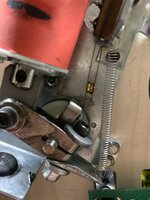Slowly trying to learn how to do routine maintenance myself...
On my TAF recently I've been seeing the left flipper stick up. Usually it has become freed either by pressing the flipper button again, or vibration, etc. On a couple of occasions it has stuck up and the game has reported "L Flipper E.O.S is stuck closed".
Turning off the machine when the flipper is stuck will leave it in the upward position, from research this suggests the problem is mechanical, not electrical.
The flipper itself is strong, and there isn't obvious sticking in the sleeve or anything like that.
Lifted the playfield and noted that at the full travel of the flipper bat the mechanism appears to get wedged against the longer EOS leaf. It looks to be like the leaf isn't long enough? Though I couldn't explain why a leaf would lose material...

Could it be the case that my flipper is traveling too far instead? Is that a thing?
I've been told by someone else (who hasn't seen it in person) that they think it needs a full flipper rebuild? Surely I can just replace the EOS switch can't I?
Thanks in advance.
On my TAF recently I've been seeing the left flipper stick up. Usually it has become freed either by pressing the flipper button again, or vibration, etc. On a couple of occasions it has stuck up and the game has reported "L Flipper E.O.S is stuck closed".
Turning off the machine when the flipper is stuck will leave it in the upward position, from research this suggests the problem is mechanical, not electrical.
The flipper itself is strong, and there isn't obvious sticking in the sleeve or anything like that.
Lifted the playfield and noted that at the full travel of the flipper bat the mechanism appears to get wedged against the longer EOS leaf. It looks to be like the leaf isn't long enough? Though I couldn't explain why a leaf would lose material...

Could it be the case that my flipper is traveling too far instead? Is that a thing?
I've been told by someone else (who hasn't seen it in person) that they think it needs a full flipper rebuild? Surely I can just replace the EOS switch can't I?
Thanks in advance.

